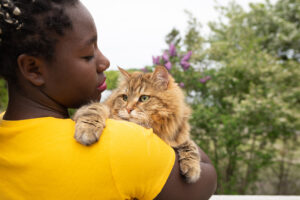The loss of a beloved family pet can be difficult for children and teens. Some children are less affected when they have knowledge of a pet’s short life span. Take for example, a fish or hamster. Children seem to understand these pets will not live as long as a cat or dog. Most children understand euthanasia will relieve a pet’s suffering when they are sick and painful.
When a pet is terminally ill, parents can prepare their children for the inevitable loss through open and honest discussion. If a pet dies unexpectedly or due to a tragic consequence, acceptance may be harder. “When a pet dies suddenly, it highlights the unpredictability of the world. It tells children that the people and animals they love can die without warning,” according to Abigail Marks, a clinical psychologist in San Francisco who specializes in childhood grief.
Joshua Russell, assistant professor and Anthropology Program Director at Canisius College in Buffalo, has studied the effects losing a pet has on children. “Many kids describe their pets as siblings or best friends with whom they have strong connections,” according to Dr. Russell. A study of 12 children between the ages of 6 to 13 conducted by Dr. Russell found some children describe the loss of a family pet as the “worst day of their lives” even years later. In addition, this study found children construct creative ways to rationalize a pet’s passing. Dr. Russell’s research also revealed the way a pet dies influences how children process grief. “Children, in particular, have a distinct sense of existential fairness around whether or not an animal lived until an appropriate age,” said Dr. Russell.

Emotions displayed by children can be different from that of adults. Children won’t always cry or display emotion immediately. This should not be interpreted as indifference. It simply means a child is processing death differently. Age and development also play a role in how children process grief.
Kids under the age of 5 have a harder time understanding a pet is gone forever because they have a difficult time grasping the concept of death. One way younger children can express grief is through play. Following the death of a pet, a child may pretend a favorite stuffed animal is sick and dies. Parents can show their support by fully participating in this imaginary play.
Another way for parents to help their children process a pet’s death is through books. A few titles include “Goodbye, Brecken,” by David Lupton, written for children ages 4 to 8; “Kate, the Ghost Dog: Coping With the Death of a Pet,” by Wayne L. Wilson, ages 8 to 13; and “Memories of You,” by Erainna Winnett, ages 6 to 10. Your child will probably have more questions after reading such books. These questions can lead to more discussion about love, loss and what happens after death. Honesty is important. It will help your child realize death is not a taboo subject and it is okay to discuss painful feelings. Doing so will help a child be better prepared for future losses.
Grief ebbs and flows. A grieving child may be crying one minute, then be found laughing and playing the next. This is entirely normal. However, if your child begins having nightmares or you notice increased anxiety or difficulty sleeping, you might consider consulting a psychologist to help your child learn coping techniques.

Creating a goodbye ritual is important. Rituals around death are meaningful. They are also helpful in processing grief. Families can decide what type of ritual is most meaningful. Perhaps a small memorial service in which your pet’s ashes are scattered somewhere significant. Another possibility is to plant a tree or create a scrapbook dedicated to your pet. Doing so will help you and your child process the loss as well as honor the indelible role your pet played in your family.
Our pets are family. When a pet dies, it can be quite difficult for adults and children alike. If a beloved pet is sick or old and experiencing quality of life issues, begin having conversations with your children about the next steps. Kids are smarter than we sometimes give them credit for being. Though we as parents want to protect our children and prevent them from hurting, shielding them from one of life’s hardest lessons will not make it easier. Talk to your kids. Involve them in what is happening with your pet. Facing the inevitable together as a family will certainly be healthier and perhaps make it easier for everyone.

